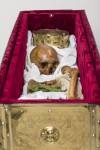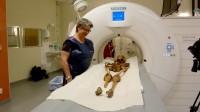 On April 23rd, 2014, researchers from Uppsala University opened a reliquary casket in Uppsala Cathedral to study the bones of King Eric IX of Sweden, the patron saint of Stockholm. The primary goal was to compare medieval remains to modern ones looking for changes in bone density for an interdisciplinary osteoporosis study, but while they were in the neighborhood, the research team examined the skeletal remains in the hopes of answering some questions about his national origins, health, diet and violent death.
On April 23rd, 2014, researchers from Uppsala University opened a reliquary casket in Uppsala Cathedral to study the bones of King Eric IX of Sweden, the patron saint of Stockholm. The primary goal was to compare medieval remains to modern ones looking for changes in bone density for an interdisciplinary osteoporosis study, but while they were in the neighborhood, the research team examined the skeletal remains in the hopes of answering some questions about his national origins, health, diet and violent death.
The University has now released the first results of the study of Eric’s bones, and so far the osteological evidence is remarkably congruent with the stories told about him at least a century after his death. Since no contemporary writings about him have survived and the later histories are hagiographies that frame him as a saint in life, a martyr in death and a miracle-worker after death, it’s hard to know what’s fact and what’s legend. The study attempted DNA extraction and analysis, performed stable isotope analysis of his teeth, did a forensic examination of the bones looking for ante-mortem and perimortem wounds, radiocarbon dated the bones and enlisted orthopaedists and radiologists to determine his vital statistics and state of health.
There are 24 bones in the casket, 23 of them from the same person, plus one random shinbone. The group of 23 are the bones of a man about 35-40 years old who was 171 centimeters tall (5’7″). CT scans found no medical conditions evident on the bones. He did not have osteoporosis or suffer any kind of bone loss. On the contrary, his bone density was 25% greater than the average young man today. Eric was strong and very physically fit. Radiocarbon dating results are consistent with his having died in 1160.
 Stable isotope analysis found one reason for his excellent health: he ate a great deal of freshwater fish. Kings had access to a great quantity and variety of animal protein, thanks to plentiful game and freshwater fish available on great estates. Eric ate both land animal protein and fish but emphasized the latter.This conforms to accounts of him in the hagiographies which describe him as fasting often out of religious devotion. Fasting in the Middle Ages didn’t require abstention from all food. It was usually meat that was excised from the diet, sometimes extended to animals products — butter, milk, cheese, eggs — during penitential seasons like Lent. The more extreme strictures were primarily observed by monks or individual ascetics. For lay Christians over most of the liturgical calendar, there were three fast days: Wednesday (the day Judas took 30 pieces of silver to betray Christ), Friday (the day Christ was crucified) and Saturday (the day dedicated to the Virgin Mary). Game birds like swan and peacock that only the aristocracy had access to were exempt from the no-meat rule.
Stable isotope analysis found one reason for his excellent health: he ate a great deal of freshwater fish. Kings had access to a great quantity and variety of animal protein, thanks to plentiful game and freshwater fish available on great estates. Eric ate both land animal protein and fish but emphasized the latter.This conforms to accounts of him in the hagiographies which describe him as fasting often out of religious devotion. Fasting in the Middle Ages didn’t require abstention from all food. It was usually meat that was excised from the diet, sometimes extended to animals products — butter, milk, cheese, eggs — during penitential seasons like Lent. The more extreme strictures were primarily observed by monks or individual ascetics. For lay Christians over most of the liturgical calendar, there were three fast days: Wednesday (the day Judas took 30 pieces of silver to betray Christ), Friday (the day Christ was crucified) and Saturday (the day dedicated to the Virgin Mary). Game birds like swan and peacock that only the aristocracy had access to were exempt from the no-meat rule.
Wounds on his bones also seem to fit the stories about Eric. His cranium had one or two healed wounds, possibly inflicted by sharp weapons. He fought a war, some call it a crusade, against pagan Finland, which would have afforded him plenty of opportunities for this kind of injury. The unhealed wounds inflicted at the time of his death match his story even better.
The saint’s legend says that in the king’s final battle, the enemy swarmed him, and when he fell to the ground they gave him wound after wound until he lay half dead. They then taunted him and finally cut off his head. The remaining bones have at least nine cuts inflicted in connection with death, seven of them on the legs. No wounds have been found on the ribs or the remaining arm bone, which probably means that the king wore a hauberk but had less protected legs. Both shin bones have cuts inflicted from the direction of the feet, indicating that the victim lay on his front.
A neck vertebra has been cut through, which could not have been done without removing the hauberk, i.e. not during battle. This confirms that there was an interlude, as described by the taunting in the legend, between battle and decapitation. At no point do the documented wounds gainsay the account of the fight given by the much later legend.
One thing that contradicts the hagiographies was an isotope analysis finding that suggests he spent the last decade of his life not in Uppsala, but in the southern province of Västergötland. This is only a preliminary finding, however, since stable isotopes have to be compared to previously recorded values in order to determine geographic locations and there’s still a lot of comparing to be done.
DNA analysis is still pending as well. Researchers were able to extract DNA samples successfully, which is a major hurdle to leap when dealing with 900-year-old bones. The DNA analysis is expected to take another year. They have DNA from King Magnus III of Sweden (reigned 1275-1290) who was descended from Eric IX through his mother Ingeborg. They will be compared to confirm the bones are indeed Eric’s.
Ruffians for the propagation of the Christian faith and -of course- ones own earthly power.
In Eric’s case -maybe apart from his own later sainthood- things must have gotten terribly wrong. In fact, most of the early Swedish kings seem to have been assassinated and there even were crusades to Finnland.
The Chronicle of the Kings of Norway, however, claims that:
“[Thangbrand, the priest] A passionate, ungovernable man, and a great manslayer; but he was a good scholar, and a clever man. The king [Olaf] would not have him in his house upon account of his misdeeds; but gave him the errand to go to Iceland, and bring that land to the Christian faith.
[and in Iceland] Thorvald Veile and Veterlide the skald composed a satire about Thangbrand; but he [Thangbrand] killed them both outright. Thangbrand was two years in Iceland, and was the death of three men before he left it.”
Another two years later, around 999 AD, the conversion of Iceland was eventually decided at the next Althing.
“King Olaf took here [in northern Norway] much gold and silver, and other property of weapons, and many sorts of precious effects; and all the men who were with Raud he either had baptized, or if they refused had them killed or tortured.”